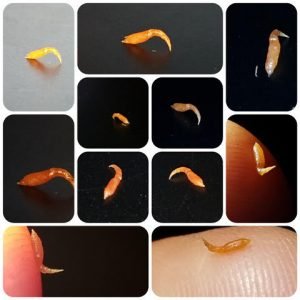
Imagine you’re at a party, and someone sets up camp in your living room without asking. That’s kind of how these worms operate. They’re sneaky, and while they’re not actively harmful in the grand scheme, they definitely make life uncomfortable for their hosts. So, let’s dive into this fascinating world of wolf worms to see just how they interact with their furry hosts and what it means for the ecosystem.
What Are Wolf Worms?
Wolf worms are the larvae of the botfly. You might think of them as tiny invaders, and they make their entrance into the lives of their hosts in a rather unique way. The adult botfly captures a mosquito, laying its eggs on the mosquito’s body. When the mosquito bites an animal, voila! The eggs are transferred to the host’s skin. It’s a crafty method of getting their offspring started on life in a new home.
Once inside, these larvae burrow into the skin and create a small breathing hole. This is where they breathe while feeding on the host’s tissue. Here’s the thing—this can lead to discomfort for the animal, but the larvae don’t usually kill their host. Instead, they just take up residence for their development. In a way, you could say they’re like tenants who don’t pay rent!
Who Are the Common Hosts?
Wolf worms often target a range of hosts, but some animals are more common than others. Let’s look at the usual suspects.
- Rabbits: These fluffy creatures often fall victim to wolf worms. Their soft skin and propensity for hiding in dense underbrush make them prime targets.
- Squirrels: With their bushy tails and nimble movements, squirrels also find themselves dealing with these pesky larvae. They might think they’re quick enough to evade danger, but the botfly has other plans!
- Wild mammals: Larger animals, like deer or even foxes, can be hosts too. They may not show the same signs of discomfort as smaller animals, but they can still be affected.
These animals have one thing in common: they often live in habitats where botflies lay their eggs. So, if you’re out hiking and spot a rabbit or squirrel, remember they’re not just cute critters; they might be dealing with these hidden invaders.
How Do Wolf Worms Affect Their Hosts?
You might be wondering how exactly wolf worms impact their hosts. Honestly, it can be quite a mixed bag.
For many animals, the initial invasion isn’t immediately harmful. However, the presence of the larvae can cause irritation and discomfort. Symptoms might include:
– **Swelling:** As the larvae grow, they can cause significant swelling around the entry point.
– **Infection risk:** If not treated, these sites can become infected, leading to more severe health issues.
While rabbits and squirrels might not be able to vocalize their pain, their behavior often changes. They might become more withdrawn or less active since they’re dealing with discomfort. It’s not a pleasant situation for our furry friends, and it’s essential to keep an eye on wildlife health.
How Do Animals Fight Back?
While it may seem like wolf worms have the upper hand, animals do have some tricks up their sleeves. The most significant line of defense is their natural instincts.
For instance, rabbits and squirrels often try to groom themselves in a desperate bid to remove anything that bothers them. They will nibble and scratch at the area where the larvae are located. This self-grooming can sometimes help, but in severe cases, they might need a helping hand from humans or other animals.
Interestingly, some species have developed more specific behaviors to cope. For example, you may spot a squirrel shaking its body vigorously; this is a way to dislodge any irritating critters.
The Role of Nature in Removing Wolf Worms
Nature has a way of balancing things out, and for wolf worms, there’s a surprising ally. Predators like birds and certain insects can serve as a natural control mechanism. When a bird preys on an infected animal, it may help reduce the number of wolf worms in that animal’s body.
Additionally, decomposers in the ecosystem can break down the remains of infected animals, spreading nutrients in the soil rather than allowing the issue to proliferate. This cycle of life shows how interconnected these beings are, and every creature has a role, even the wolf worms.
Humans and Wolf Worms: A Complicated Relationship
While wild animals deal with wolf worms in their own ways, humans sometimes intervene. Wildlife professionals and conservationists often step in to help infected animals. This could involve:
– **Monitoring:** Keeping an eye on populations of affected species.
– **Treatment:** In some cases, they might choose to remove the larvae if the animal is suffering significantly.
However, it’s a delicate balance. Removing the larvae can sometimes lead to unintended consequences, such as disrupting the natural behaviors of the host animal. Here’s the thing—while wolf worms might sound troublesome, they’re just another part of the intricate web of wildlife interactions.
Wolf worms may not be the most glamorous aspect of the animal kingdom, but they remind us of the complexity of life. From rabbits to squirrels, these hosts navigate a world filled with challenges, and wolf worms represent just one of those challenges.
Understanding these relationships can help us appreciate the delicate balance of nature. While it might seem strange that some animals can have such pesky roommates, it’s nature’s way of creating a cycle that persists in all living beings. The next time you see a rabbit or squirrel, take a moment to think about what might be happening beneath the surface. Every animal has its story, and sometimes, that story includes a little unwelcome company.
